If you haven't read my Nikon J1 review, I suggest that you do, especially the "How's it Handle?" section, where I have several long rants about some key design elements. I'll be more brief in my objections here, so if you want the full wrath of my writing, you'll need to read the J1 review.
Also, let me be clear about another thing: this is a review of the Nikon V1, and not the J1. Be careful about making assumptions about the J1 based upon what I write about the V1, and vice versa. In practice, they are somewhat different cameras, despite sharing a wide range of traits.
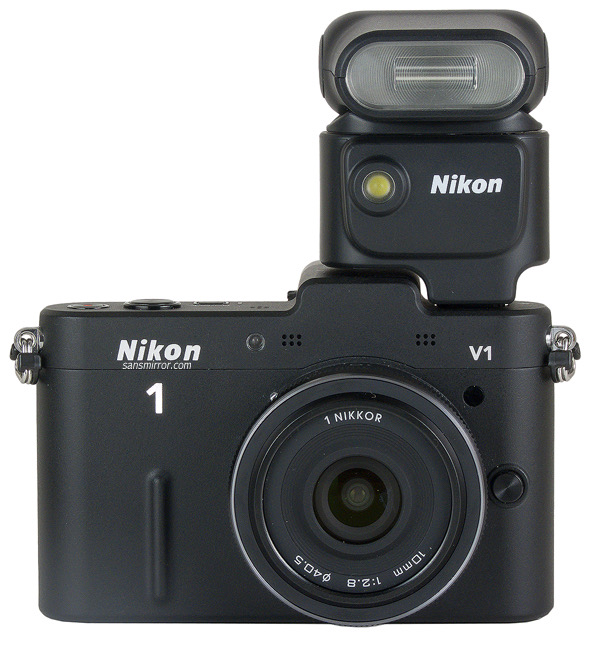
What is it?
The Nikon V1 is the "high end" model to the Nikon 1 lineup. The words "high end" are in quotes mostly because "high" is relative to the J1, not necessarily to mirrorless cameras in general.
The V1 is a bit like a mini-DSLR in a compact camera body, with a slightly disjointed mix of compact/DSLR elements to it: 10mp (2.7x crop) state-of-the-art sensor is decidedly compact like, basic 5 fps frame rate (with restricted ways to increase that), both mechanical and electronic shutters, the usual mix of exposure, ISO, and white balance settings, a state-of-the-art phase detection autofocus system, a built-in EVF (very DSLR-like), remote control capabilities, and a bevy of video features all built into a 8 ounce and highly compact body. On paper a very interesting camera.
On the back of the white or black body is a black plastic fascia containing a 3" 921k dot LCD and a compact camera-like array of buttons and dials. Up top we've got a special accessory shoe under an easily losable cover, a speaker grill, the on/off button, shutter release, and record movie button. The front of the camera is a bit more accessorized than the J1, with a slight "grip" under the 1. Two small microphone grills are on either side of the lens at the top. Curiously, the AF Assist lamp and infrared receiver on the front of the V1 are in different positions than they are on the J1. Some of that probably has to do with the connectors on the one side of the V1 (accessory slot, HDMI out) that the J1 doesn't have--there's not a lot of internal space to sort all the internal connections.
As befitting a higher end camera, the V1 only comes in white and black; we're spared from the garish colors. The black version is a bit matte in texture and quite subdued looking. The white version is a bright enamel and very tough to miss when someone is holding or using it. Given the V1's ability to be an absolutely quiet stealth camera, I think the black color is the better choice, but the white version is stylish looking, if that's what you go for.
Unlike the J1, the V1's body is a magnesium/aluminum alloy, but it shares a similar plastic back.
Like the J1 Nikon has taken a simplification theme to this new camera: it only consists of 195 parts total, or twelve more than the J1 despite having a number of additional features (including an EVF). Most Nikon DSLRs have multiple thousands of parts. Thus, the Nikon V1 is actually simpler in design than any other camera Nikon makes that's intended to be used at your eye. Does the parts reduction show? Yes and no. The uncluttered look of the V1 is somewhat welcome and hints at the type of simple, refined design that Apple, Samsung, and a few others do so well. Unfortunately, it's only a hint.
In the top plate of the V1, we have a few things that suggest its higher-end nature. First, is the hump containing the 1.4m dot EVF. This EVF provides a DSLR-like use of the camera (camera to your eye), and most things about the EVF are quite well considered. The EVF has a rubberized "cup" that's a bit minimal but won't fall off the camera easily. There's a diopter setting (-3 to +1) to adjust to your sight. The 17mm eyepoint makes it easy to see the full frame and indicators even with eyeglasses on.
Alongside the EVF is a new "accessory shoe." When you pull the plastic cover off (or it falls off--which it almost certainly will happen sometime early in your ownership of the camera) there's something that looks like a hot-shoe revealed. Only it's not a hot shoe, it's just a shoe. At the far back, hidden under the top plate there's a connector that supplies the real connection. Nikon so far has supplied a GPS, Flash, and Microphone adapter to fit into this slot, with likely more goodies coming in the future.
Like the J1, the V1 back looks and feels "cheaper" than the rest of the camera. Nikon again appears to be recycling Coolpix parts here, and this results in a very odd contrast to the more refined look (and sometimes feel) of the rest of the camera. More on that as we get deeper into the review.
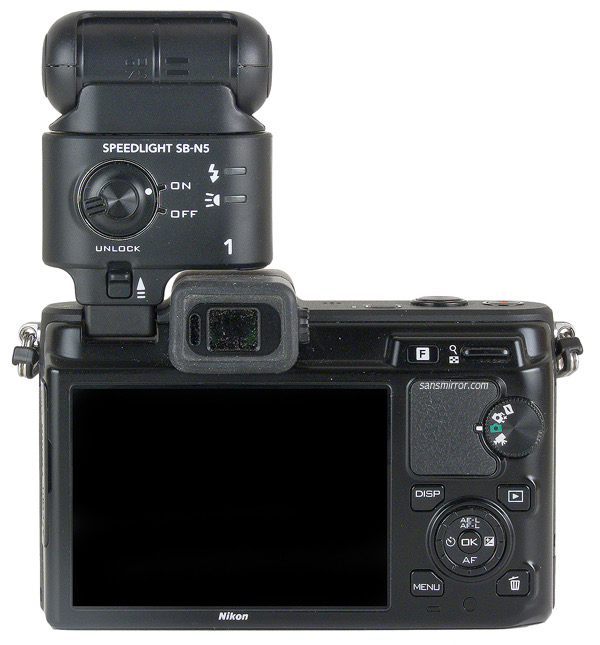
If you look closely, you'll see some differences between the J1 and V1 controls. The V1 doesn't have a flash, so it doesn't need the flash release lever. It also substitutes an AF function instead of flash on the Direction pad (flash is controlled via menus that appear only when you've got the SB-N5 flash mounted on the camera (Flash mode, Flash control, Flash compensation).
The retail list at announcement was US$900 with the 10-30mm kit lens, though we're already seeing discounting from that price. That price is high. Considerably high. This is really a US$600 camera, I think, maybe US$700 in a pinch. But US$900 puts it in a rarified class in mirrorless cameras, and it doesn't have the credentials to warrant that, in my opinion. Given the low parts count, the small sensor (sensor cost changes considerably with size), and the competition, Nikon is coming into the mirrorless market late and at a high price.
The V1 uses either an all electronic shutter that's silent and provides shutter speeds up to 1/16,000 of a second, or a mechanical shutter that has a bit more shutter speed limitation but a better flash sync speed (1/250 versus 1/60). You get to choose. Electronic shutter can also be set to a high mode that produces a faster frame rate but has some other tradeoffs.
The V1 uses an existing DSLR battery, the EN-EL15. This was a nice surprise, and certainly welcome by Nikon DSLR shooters looking to pick up a smaller camera for casual shooting.
If you're considering both the J1 and V1, see my Nikon 1 FAQ for the complete list of differences. Quite a few of those differences may be meaningful to serious shooters, so pay close attention before choosing a J1 over a V1, or vice versa.
How's it Handle?
While the V1 has a "grip," it's not anything more than a raised line of metal. In practice, it doesn't provide much leverage. Like the J1 (see my rant on this in the J1 review) Nikon has thought to sell an "optional grip." It'll set you back US$120. Sigh. Someone's dreaming at Nikon headquarters. I strongly suggest that you wait for third-party optional grips, which should appear shortly and not cost you more than a hour or two's minimum wage.
I complained about the flat-to-surface buttons on the top of the J1 model. The V1 has a slight raised edge around each button, meaning that you can find them by feel (though certainly not with even the thinnest gloves on). That's good, because I think most of you will want to use this camera up at eye level with the EVF.
One nice touch is that the camera turns on if you extend the lens (for those lenses that support it, which includes the 10-30mm and 30-110mm kit lenses; for the 10-100mm you have to turn the camera on and wait for the lens to extend automatically, which takes almost two seconds). Too bad contracting the lens doesn't turn the camera off. I know some argue that it shouldn't, but I think such symmetry is the right approach. The argument that you can't review images with the lens retracted if it worked both ways is misguided, IMHO. First, why would you retract the lens to review images? Second, even if you do want the lens retracted when reviewing images, just press the on/off button and the playback button--you don't have to have the lens extended to review images.
Changing lenses is mini-DSLR in nature. Press the lens release (close to the location Nikon DSLR users would expect it to be) and rotate the lens off the mount. The rotation is far less for mounting and unmounting a Nikon 1 lens than a Nikon DSLR lens in the F mount. Also the alignment position is different (12 o'clock instead of 2 o'clock). One nice touch is that the Nikon 1 lenses have a painted marker that's easy to see. The marker on the camera body is on the lens mount and slightly less obvious, but 12 o'clock is easy enough to remember.
On the plastic bottom of the camera we have the usual (plastic) battery/card compartment door, and a metal tripod socket centered on the lens. Unlike some camera makers (I'm looking at you Sony and Olympus), there's plenty of clearance between the battery compartment door and the tripod socket, which means I was able to use some existing small Arca Swiss plates on my J1 without blocking the door. Bravo. Full marks for the bottom designer.
It's the back where things start to fall apart, just as on the J1. That shouldn't be a surprise, as the two cameras have basically the same controls.
Again we have a mode dial that won't stay put. It is slightly better positioned than the J1, so it doesn't move as often, but I still found it moved a lot in my three weeks of travel with the camera. It also seems to me that the mode dial on the V1 model really ought to be something higher end than J1. While four basic choices felt "okay" on the low-end model, here we have a US$900 camera with enthusiast-attracting features that has the same four choices, and same problems. All the things I ranted about in my J1 review are present here, as well.
Not that the other controls on the back are all that great. The wheel/button array at the bottom right back is classic cheapo Coolpix. At least the Delete button is recessed, making it hard to accidentally toggle (twice to delete an image, like the Nikon DSLRs). But the buttons are small and the wheel a bit too susceptible to moving without me wanting it to (there's that again). Indeed, the wheel on the Direction pad of my V1 is distinctly cheaper in feel than the one my J1, and tends to jump on me when I don't want it to. Too often I found myself fighting the Direction pad and wheel while trying to set something in the menus. I'll repeat, this is a US$900 camera: it deserves better. Far better.
There are plenty of controls, they're just cheap in execution and used (mostly) poorly. For example, the F button. Would you believe that it's a dedicated function button? In each of the camera's modes (that would be the things the mode dial sets, not exposure modes) the button does something different. For stills? It pulls up the Shutter type menu (Mechanical, Electronic, Electronic (Hi)). Really? That's the thing I want to change most often and avoid the menus for? I'll bet if we take a poll on that, Shutter type will still fall way down in the results, even for the higher end Nikon 1 users. In fact, the only time I ever changed shutter type was when I wanted to shoot silently or to invoke 10 fps. This is a bit of the "Nikon knows best" kind of thought that seems to pervade the design. Only Nikon not only doesn't know best, but they failed to see other possibilities that might have been better.
This camera calls out for a Quick Menu implementation. A programmable Function button. A better built Direction pad (the lower cost D3100 has a better one, though it doesn't have a ring around it). A real AE-L button. It doesn't need much, but it desperately needs these things. The reason? Because you're going to want to use this like a DSLR, and up at your face. And when you do, trying to find and use the itsy-bitsy controls by feel isn't going to work. At least the EVF and LCD are controlled by proximity, so when you take your eye from the EVF to get a setting right, the LCD comes on automatically, and when you put the camera back up to your eye the EVF fires up again and turns the LCD off.
The EVF itself may not have the greatest resolution in the world, but 1.44m dots is enough to get by, especially since there's on a tiny amount of lag. Nikon has thoughtfully put the major information at the bottom of the display underneath the image area, not over it as it did on the J1. There is a bit of a lag in activating the EVF as you put your eye to it, which will probably annoy some people, but I didn't find it problematic. As with any activated EVF, you have to watch what you put in from of the viewfinder itself. I found that I couldn't point to anywhere near the top of the camera's rear LCD without the LCD going black and the EVF firing up, which is definitely annoying.
The dependence on menus to change things is the weak aspect of the control system. The SHOOTING menu has 20 items on it (23 with flash attached), the SETUP menu another 20. That tends to create a lot of key pressing or dial turning to find what you want (fortunately, the dial is a shortcut, though as I've noted, my dial is decidedly uncooperative about just moving over one thing at a time).
Again there are missing elements. Top amongst those are no live histogram (though you can get one on playback). No customization of any control. No cancellation of automatic image review. All of these detract more on the V1 than on the J1. The V1 doesn't actually feel higher-end than the J1 when it comes to controls. It just has an EVF and an accessory slot as obvious additions, plus a few more odds and ends here and there that aren't controls.
Right hand position on the V1 is better than it is on the J1. The rear "thumb rubber" is larger and located further in and slightly down on the V1 as opposed to the J1. On the J1 the resulting hand grip feels slightly awkward and tenuous (almost off the camera). Not so on the V1. Of course, there's nothing much for your thumb to do, and the one control you'll want to use is located far to the edge of the camera, just like the J1. Still, with the camera at your eye you're holding the V1 much more like a DSLR, and it feels more natural and less tenuous than the J1's grip feel.
I think Nikon made a critical mistake with this camera. The enthusiasts that appreciate the mini-DSLR nature of the V1 are going to find a lot lacking in this camera, especially for the price they paid for it.
Still, all those handling problems notwithstanding, there are some things to like about the V1. I really do like the mini-DSLR aspect. I almost always used the EVF during my first three weeks of testing that produced this review. It's easy to brace and steady the camera, and in bright light the EVF is a better choice than the rear LCD for composing anyway. But as with the J1, I found that I had to adapt to the camera rather than customize it and make the camera adapt to me. That's a missed opportunity here, as with the right controls and customization--and it wouldn't take much--this could indeed be the camera I carry around with me all the time.
Again, as with the J1: watch the default settings. See my list of changes that I gave in my J1 review if you need help figuring out what to change.
How's it Perform?
Battery: The choice of the EN-EL15 was a good one by Nikon. Even using the EVF most of the time I had very good battery life. Typically 400+ shots, but sometimes up in the 600 range per charge. This is well out of the compact camera range and into the one-battery-a-day range, and about the best I've gotten with an EVF equipped camera. I have no real complaints about the battery (though having a charger larger than the camera is interesting).
Focus: As I noted in my J1 review, the Nikon 1's autofocus system is quite good. Very DSLR-like in most aspects, including speed and tracking ability. In the mirrorless realm, there really isn't anything that matches the Nikon 1's focusing. Some Olympus/Panasonic m4/3 camera/lens combinations can acquire focus almost as fast as the Nikon 1 models, but they can't track motion like the J1/V1 can.
This is the result of phase detect sensors being built into the imaging sensor, coupled with the high frame rate of the sensor, plus all the computational horsepower that Nikon has stuffed into the camera. Certainly in bright light you might be fooled into thinking you're shooting with a DSLR (assuming you're out of the default settings, as I note above). Focus acquisition is swift and focus tracking good (typically on the D3100/D5100 level; in a few cases, better). With one exception: you need a subject that has contrast in it. It appears that the focus system on the Nikon 1 tries to confirm that it found focus by looking at contrast information. If you don't have any contrast under the area the camera is focusing on (for instance, the side of a dark ship), all bets are off. Obviously, this problem is bigger in low light with non-contrasty subjects (think black cow at dawn). But in good light with subjects that have contrast in them, I'd characterize the focus as DSLR-like. Not D3s-like, but certainly in the realm of DSLR expectations.
Side note: the 10-100mm in AF-C seems to have the tendency to do that "one last step out and back" focus thing that many contrast-based systems. The lens is eerily silent (both in focus and zoom), but I found that with quick moving subjects the 30-110mm was the better choice simply because of that little momentary jerk at the end of focus operations--the 30-110mm had far less tendency to do this (typically only in low light/contrast). Another oddity about the 10-100mm: if you unmount the lens without powering down, it stays extended.
The V1 has more accessible focus settings than the J1, as it devotes a button on the Direction pad to focus, which gets you to the AF-A, AF-S, AF-C, and Manual Focus options quickly. The Auto Area, Single point, and subject tracking AF-area modes are in the menu system, though, so full control is a button pressing, menu navigating dance. AF-A works better on a Nikon 1 than it does on most low-end Nikon DSLRs, which is to say that the pause before the camera decides to switch from AF-S to AF-C when it detects moving subjects is faster. Still, I don't think it's the right choice.
Which brings us to birds in flight (BIF). I had ample opportunity to try the V1 with a wide variety of shore birds in New Zealand. That means close in, fast moving birds. Indeed, I had a lot more trouble finding and framing them as they whizzed by me than the camera did finding focus. However, as with the Nikon DSLRs, getting a high hit rate of in-focus (or at least acceptably focused) images means spending some time fiddling with settings. AF-A tended to not acquire focus fast enough in this test, but once acquired, it tended to hold it (at least as long as I could track the bird reasonably well--again, these birds were quite close and moving fast). I had better success with acquisition using AF-C, though slightly worse tracking, especially when I used Single point. Surprisingly, cluttered backgrounds didn't tend to throw the Nikon 1 off focus any more than they do with the Nikon DSLRs (it will happen from time to time, but if you've set everything right and are really following the bird steadily, the camera won't tend to focus to the background).
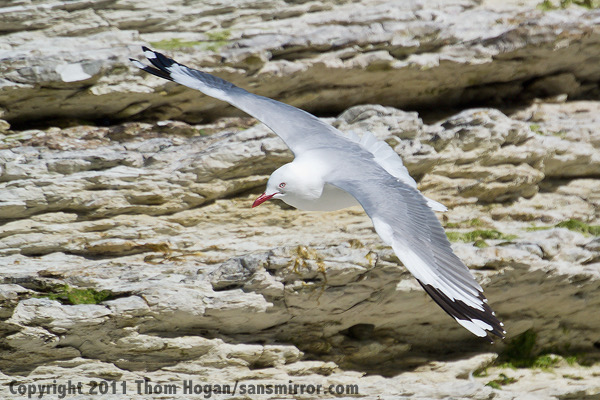
A tough challenge for any camera. Fast moving bird close in and changing direction. Busy background just behind it.
Single point is a little frustrating at first, as you have press the OK button to get control of the point. But once you've done that just use the Direction pad to move the focus point. One nice touch that BIF shooters will like is that you can roll the Direction pad wheel to move the focus point left and right very quickly. Unfortunately, Nikon cancels the Single point movement when you take a picture or the meter times out, so you're going to be hitting the OK button a lot.
Subject tracking is tricky. In theory, it should track what was originally in the (Single point-like) box. I've found Subject tracking works exceptionally well on subject motion towards and away from the camera, less so on side-to-side, slightly diagonal-to-the-camera motion.
I still have some work to do to completely assess what focus settings work best in which situations, but the one thing I missed most was the presence of an AF On button. You can assign the AE-L/AF-L button to AF lock only, but that's sort of the opposite of what I really want.
I'm very convinced that I can treat a V1 like a DSLR in most respects: right settings, steady follow of the subject, and sometimes a bit of prefocus and AF sensor moving get me what I want. Indeed, the V1 was so much like a DSLR in this respect, I really missed not having an AF-On button and having the ability to switch all the focus parameters by external control.
The next question tends to be focus for video. As with the J1, I'd call the V1 respectable. Better than most Nikon DSLRs in tracking focus in video, but not as good as some dedicated camcorders (especially true of the lens that's designed for video, the 10-100mm). That's good, because manual focus isn't really an option with the V1. Manual focus is controlled by the dial around the Direction pad and there's no focus aid available other than zoom. The EVF is basically a VGA-level screen: even with zoom it's a bit too coarse to make out fine focus detail. This camera needs a peaking focus aid.
Overall, focus performance wasn't something that concerned me with the V1. It would have been nice to have more direct control over the focus system, but I learned to live with what control I do have.
Exposure: Unlike my J1, my V1 was more spot on with exposure. I suspect that's because I was normally using the mechanical shutter, not the electronic shutter. I'm starting to come to the impression that very bright things in the frame with the electronic shutter active are the trigger for my J1's slight hot exposure tendency outdoors. Still, even on my V1 with the mechanical shutter active I found myself overriding the camera's selected exposure more often than I do with my D3 bodies. Given the Nikon 1's narrower dynamic range, you really want to be precise with exposure. Unfortunately, we have no real tools to do that with other than the after-the-fact histograms. No highlights blinkies, no live histogram.
Buffer: I've seen a lot of people complain about false advertising with the Nikon 1 models. They see that 60 fps (or even 10 fps) a second ability and they get all starry eyed and unrealistic. Even a D3s can't do those things without compromise, why would you expect a camera that costs less than one-fifth the price to not also have some limitations?
Let's go to the really good news first: there's a lot of memory in the V1. 1GB of DRAM to be exact. Coupled with only 10mp of image data and the fast internal pipeline, at the 5 fps normal limit you can shoot for a long time before filling the buffer. As much as nine seconds of raw files (hint: turn off Long Exposure Noise Reduction and don't use higher ISO values). With JPEGs, up to 20 seconds. You may have a long wait for buffer clearing (more than a second per image), especially if you're using a non state-of-the-art card, but this is still more like a DSLR-level of performance than a compact or mirrorless system camera performance. Put another way, you can shoot short 5 fps bursts with very little penalty. Fill the buffer, though, and you'll be waiting a bit.
If you opt for the Electronic (Hi) shutter, you can choose 10, 30, or 60 fps. But there are some additional restrictions: focus is performed in the central area, and only for the initial shot in the sequence for 30 and 60 fps. At 60 fps you only have a one-second buffer, max. The camera also switches to Program exposure mode with Auto ISO unconstrained. Obviously, these are tough restrictions, but then again, what other camera is going to do that? The focus limitations mean you'll have to carefully consider your position relative to subject motion, and you'll have to time your shooting for the narrow buffer window, but still, it's a rather remarkable attribute for a small camera to have. I'm not going to pan it like many have.
Image Quality: There's no real difference in image quality between the J1 and V1. I can measure a small difference, but I suspect that's just the difference of the dust filter on the J1. Overall, the V1 exhibits the same fine traits as the J1 did.
One thing that Nikon has gotten very good at lately is making a broad range of cameras with different sensors that all produce essentially the same looking images. If you're familiar with Nikon's Picture Controls on any other Nikon camera (Coolpix, DSLR), the V1 (and J1) basically will prove to be familiar and produce very similar images at the same settings.
That last sentence has both good and bad in it. The good is that Nikon's JPEG files are generally quite clean, free of color noise even when they do show noise, have somewhat more accurate color than most cameras at the least fiddly settings (Standard, Neutral), and have almost no JPEG artificating to be seen, even when pushed to the limit. The bad is that Standard (and especially Landscape and Vivid) are a bit contrasty, sharpening is understated (even when boosted), and "accurate" color isn't actually what most people are attracted to. Personally, I have no problem with the "bad" list: I tend to use Neutral and I post process even my JPEG images. I start from relatively defect-free pixels therefore, and can move the color, contrast, and sharpening as I see fit.

Here's where DSLRs and compact cameras tend to part company: high contrast scenes. No camera is going to hold the sun and detail in a foreground in shadow. Not surprisingly, the Nikon V1 is dead in between the DSLRs and compacts in capturing a scene like this. We're losing definition in the blown out area around the sun, but we're still holding some detail in the shadows. My NEX-5N held this scene somewhat better than the V1, but I was a bit surprised at how close the V1 was overall.
Noise: Pixel peepers won't be happy with the V1, everyone else will.
It's a small sensor camera. In a scene with a wide range of lighting, keeping exposure to retain highlights may push you down into the lower ends of its dynamic range where some noise lurks. That said, I was surprised at how little noise we see and how well controlled it is. Here's what you get with JPEGs at (mostly) default settings (I turned Active D-Lighting off):
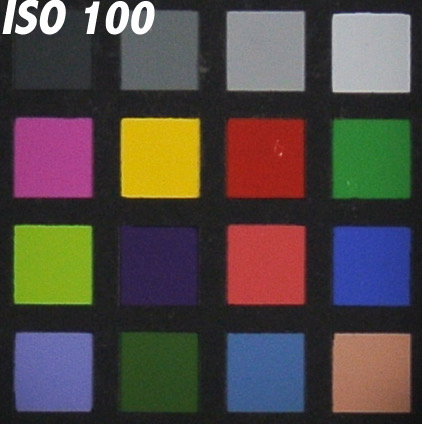
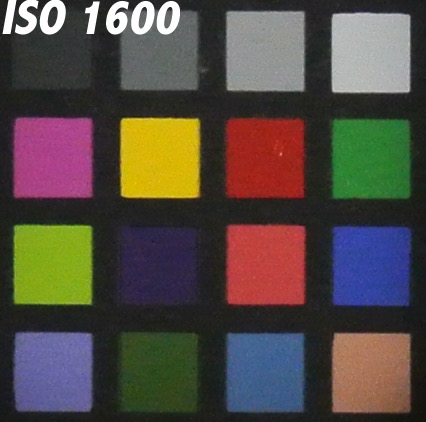
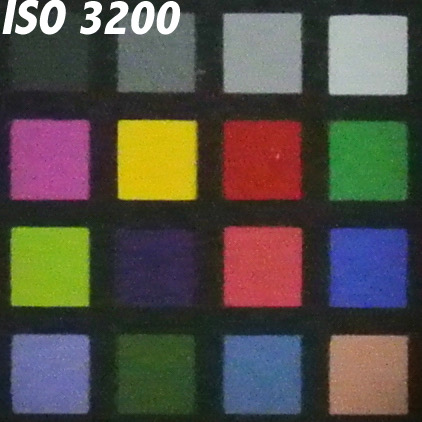
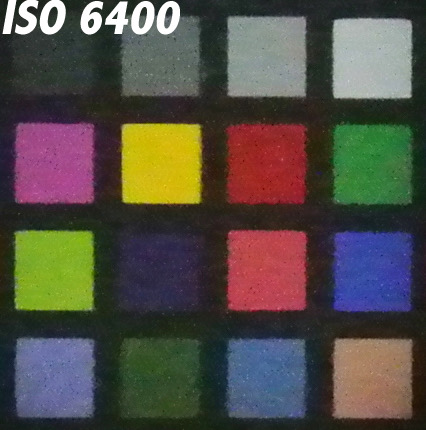
With JPEGs, they're relatively clean through ISO 1600, especially considering the sensor size, but start to degrade rapidly at ISO 3200. HI 1 (ISO 6400) is borderline usable, and certainly not where accurate colors or detail need to be preserved.
One bad piece of news is that Nikon is cooking raw files above ISO 400. There's some form of noise reduction happening above that ISO value in raw data that can't be turned off. It's one of the reasons why I suggest Auto ISO 400 as the max setting.
I see no hint of amp noise in the maximum two-minute image you can take with the V1 (on the somewhat misnamed "Bulb"--why Nikon didn't just add 60" and 120" to the shutter speeds, I don't know). However, with Long Exposure Noise Reduction turned off and at ISO 400, there is a wide sea of hot pixels, and I see some regularity to these, which indicates that even two minutes may be pushing this sensor. With Long Exposure Noise Reduction turned on, the camera is unavailable for another two minutes, and most, but not all, of the hot pixels are taken care of. (Note that I tested at ISO 400 because above that raw files are cooked by Nikon, so you can't actually see what the sensor was doing.)
Final Thoughts
I'm perfectly fine living on the cutting edge and using 1.0 products. Sometimes I bleed a little. I may need to carry a few bandages while traveling with the V1.
I'll say right up front that I actually (mostly) enjoyed using the V1. On the same trip I had a D7000, J1, and NEX-5N. I found myself picking up the V1 more than the others, and it's partly because of the built-in EVF in a very small, light package. For some of us, that's just how we learned to shoot: camera to the eye. The V1 body is small enough and the EVF positioned so that I can actually "two-eye" it. My left eye is open and looking at the whole scene (good thing it's farsighted) while my right eye is looking through the EVF at the composition. Even with glasses on this works just fine.
The frustration with the V1 is that there's little I can do with my right hand while my eye is at the viewfinder other than press the shutter release and adjust aperture (or shutter speed if I'm in shutter-priority mode, or both if I'm in manual exposure mode). On the one hand, that's refreshing in that with nothing else to do I can concentrate on the composition (right eye) and timing (both eyes). On the other hand, I'm used to juggling more, and want to.
So again, Nikon shot low in terms of target user. Too low in my opinion. A few more control options would have gone a long way in distinguishing the V1 as a truly high end mirrorless option. Had they done that, none of us would be complaining about the J1 quite so much, either. We'd have two high performance cameras, one (J1) clearly mostly for the all-auto crowd (compact user), the other (V1) more closely aligned to the DSLR control freak crowd (but still not all the way there). As it is, Nikon shot two arrows into the same target.
The V1 is the better arrow. It is a more well-rounded camera and certainly more what the compact user stepping up probably wants (mini-DSLR). But here's the other problem: the V1 costs too much. Considering that the D5100 costs less, has better controls, and has higher image quality overall, the V1 becomes more of a "do you want it smaller?" option at the sales counter. The cost for making it smaller (and losing control, a swivel screen, better high ISO capabilities, more megapixels, and more) is currently US$100. Something doesn't seem right about that choice. Indeed, it's difficult for me to tell you to choose the V1 unless size is the number one parameter on your checklist.
No, the real issue here is Nikon's notion of "target customer" and how they designed to that. It's easy to understand how they convinced themselves that "a compact user moving up doesn't want complexity so let's remove most of it and hide the rest." As I noted in my J1 review, what Nikon didn't do is consider the DSLR user moving down. We certainly don't need or want to have complexity removed or hidden.
The funny thing is that all the mirrorless makers have had some variation of this design-to-market problem. Sony's original three-button UI on the NEX-3 and NEX-5 targeted too low, and they had to quickly improve that via firmware to better please the higher-end users those cameras tended to attract (because of the large sensor and high-ISO capability). Likewise, Olympus and Panasonic drove very fast to "consumer model" cameras (E-PM1 and GF3), but there's been resistance from users there, too. I have no problems with there being a low-end model in mirrorless. But all the makers (other than perhaps Samsung) seem to have initially targeted the low-end as being the primary force in driving mirrorless design.
Nikon now has a curious lineup. We've got the L and S Coolpix models that are heavy into the novice-user-hide-the-complexity design theme. Above that we've got Coolpix P models that are actually much like a mini-DSLR in terms of complexity and control. Above that we've got the Nikon 1 models that are way back into the novice-user-hide-the-complexity theme. Above that we get the D3100 with its totally botched Guide mode and plenty of DSLR complexity when you learn to avoid Guide mode. And finally from the D5100 up we get lots of control and complexity that escalates until we get the everything-and-the-kitchen-sink D3 models. This product ramp isn't linear or sensical. Coolpix users don't really learn how to use a Nikon 1 and Nikon 1 users don't learn how to use a Nikon DSLR. This is classic evidence of "no overall leader" in product management. It's as if Apple made the iPod Touch with one interface, the iPhone with another, and the iPad with yet another.
Even more so than the J1, Nikon missed a real opportunity with the V1 design. Thing is, I really like the V1. It takes very nice images, it has a great deal of performance for a small camera, it's a passable video camera, and it really is a tough competitor against bigger sensor models from other companies. The more I used the V1 (and J1), the more I found things I liked about the images I could get with them.
The problem is that the design gets in my way a bit too much. Yes, I'm a high end user, and a very sophisticated one. Yet I think the design probably gets in the way of the novice user moving up, too. Even something simple, like the too easily displaced mode dial, is enough to frustrate any photographer. But it doesn't stop there. In particular, the V1 is missing some basic direct user control (outside the menu system). Scrolling menus with 20 items on them is so out of whack with the sophistication of the user that would be attracted to the V1, I don't understand how Nikon missed on that point. Perhaps some of the issues can be fixed via firmware changes (e.g. assignable F button, assignable zoom lever, some careful reworking and reorganizing of menus, a quick menu option).
The good news is that the one area they didn't mess up is the performance. It has exceptionally good focusing for a small camera, it produces exceptionally good images for the size of its sensor, it has DSLR-like (and not just any DSLR, but high-end DSLR) lag, frame rate, and buffer performance. It has a ton of video capability including some manual controls that many of its bigger DSLR brothers don't have. When you discover those things about the V1, you really, really want to like and use this camera.
As I noted earlier, I've had to adapt to the camera. The performance is good enough that I have been willing to do just that. I put the V1 to the real world test with two weeks scouting locations in New Zealand, and from the performance standpoint, it never really disappointed me or let me down. Every now and then I'd get caught in some of the novice-or-else design decisions and get frustrated, but as I note, I adapted. I found small ways to try to cheat the UI reaper. I got the camera out of its defaults and set into something that could handle 80% of what I encountered, and adjusted my shooting a bit to handle the rest. I managed to get images that hold up against what I could do with a DSLR (though obviously only 10mp versus today's 12 to 24mp DSLRs). That's saying a lot. It's actually harder to accomplish some of the shots I made with the V1 with the m4/3 and NEX models I'd previously been using as my small camera.
We're at the point in the review where I need to decide whether to recommend the V1 or not. Nikon did not make this decision easy. There are a lot of flaws and a lot of big successes here. Any decision is going to be a delicate balancing act. So let me start by just describing the things that would have clearly tipped me into recommending the camera: stiffer or lockable mode dial, better Direction pad dial, customization (function button, image review, AE-L lock hold), and live histograms. That would have been enough change to clearly tip the scale. Unlike with the J1, though, I believe I can give the V1 a Recommended rating without the "barely" qualification. It's really the EVF and how it makes the V1 into a mini, but mostly automated, DSLR that does that. Little touches such as the external flash and GPS, the infrared receivers on both front and back, some modest hand position/grip changes, and a better rear LCD also help remove the "barely."
Let's hope Nikon is listening and starts fixing the broken. Because in size, build, and most performance characteristics, this is a heck of a camera.
2018: this model is out of production and no longer available new. But used copies can easily be found. Also, check out the later V2 and V3 models.
Get Thom Hogan's Complete Guide to the Nikon 1, which covers the Nikon V1 model in more depth and detail than you'll find anywhere else. Click on the book cover to find out more:
Support this site by ordering your V1 camera from the following advertiser:
